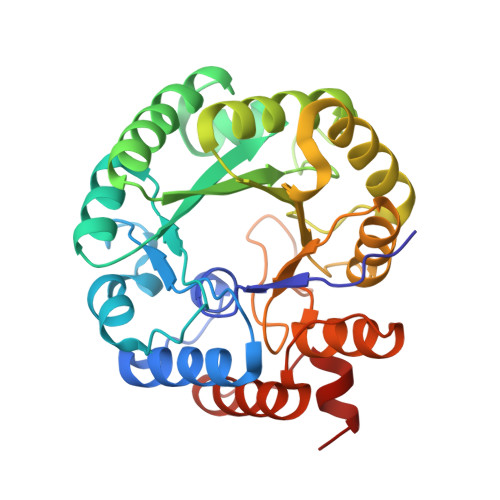Functional insights into human HMG-CoA lyase from structures of Acyl-CoA-containing ternary complexes.
Fu, Z., Runquist, J.A., Montgomery, C., Miziorko, H.M., Kim, J.J.(2010) J Biol Chem 285: 26341-26349
- PubMed: 20558737
- DOI: https://doi.org/10.1074/jbc.M110.139931
- Primary Citation of Related Structures:
3MP3, 3MP4, 3MP5 - PubMed Abstract:
HMG-CoA lyase (HMGCL) is crucial to ketogenesis, and inherited human mutations are potentially lethal. Detailed understanding of the HMGCL reaction mechanism and the molecular basis for correlating human mutations with enzyme deficiency have been limited by the lack of structural information for enzyme liganded to an acyl-CoA substrate or inhibitor. Crystal structures of ternary complexes of WT HMGCL with the competitive inhibitor 3-hydroxyglutaryl-CoA and of the catalytically deficient HMGCL R41M mutant with substrate HMG-CoA have been determined to 2.4 and 2.2 A, respectively. Comparison of these beta/alpha-barrel structures with those of unliganded HMGCL and R41M reveals substantial differences for Mg(2+) coordination and positioning of the flexible loop containing the conserved HMGCL "signature" sequence. In the R41M-Mg(2+)-substrate ternary complex, loop residue Cys(266) (implicated in active-site function by mechanistic and mutagenesis observations) is more closely juxtaposed to the catalytic site than in the case of unliganded enzyme or the WT enzyme-Mg(2+)-3-hydroxyglutaryl-CoA inhibitor complex. In both ternary complexes, the S-stereoisomer of substrate or inhibitor is specifically bound, in accord with the observed Mg(2+) liganding of both C3 hydroxyl and C5 carboxyl oxygens. In addition to His(233) and His(235) imidazoles, other Mg(2+) ligands are the Asp(42) carboxyl oxygen and an ordered water molecule. This water, positioned between Asp(42) and the C3 hydroxyl of bound substrate/inhibitor, may function as a proton shuttle. The observed interaction of Arg(41) with the acyl-CoA C1 carbonyl oxygen explains the effects of Arg(41) mutation on reaction product enolization and explains why human Arg(41) mutations cause drastic enzyme deficiency.
Organizational Affiliation:
Department of Biochemistry, Medical College of Wisconsin, Milwaukee, Wisconsin 53226, USA.

















